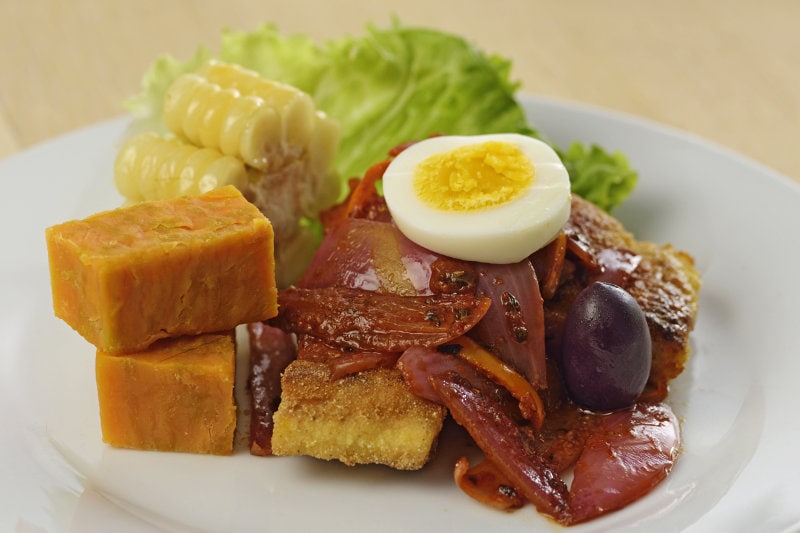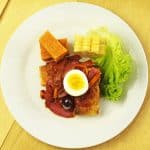Escabeche de pescado hits all the right Peruvian food-lover’s spots: crunchily fried fish fillet topped with a relish of yellow chili pepper strips, onion, garlic seasoned with yellow and panca chili peppers and black pepper. All served with a piece of corn, sweet potato and lettuce.
You might think that someone dreamt up the recipe for escabeche de pescado as a homage to Peru’s most important chili peppers – yellow chili and panca chili. But the dishes origins actually stem from a tradition from another distant continent.

Time to learn more about this cold dish that won’t leave you cold.
Fish escabeche origins
We’ll dish up the exotic origins right away: the word escabeche is a Spanish version of the Arab word sikbaj (pronounced “iskebech”), the term for a traditional way of conserving food using sugar and vinegar. Many Spaniards that arrived in Peru came with their Arab servants, who used this method of conserving food.
And that’s how the foundation of the recipe made it to Peru. In those days it was very important to use ingenious ways to conserve the food but this method actually also enhances the flavor of the fish or meat.

It’s easy to imagine that these immigrant cooks were eager to experiment with local ingredients. It’s possible that during one of these experiments they decided to use the ubiquitous ají amarillo and its infinitely milder cousin, ají panca, to see what happened.
It’s important to note that escabeche is not a very spicy dish – the amount of ají amarillo used is minimal.
The ají panca mostly fulfills the task of adding flavor yet not heat, as well as giving the dish its distinctive deep, red tinge. I think the fact that the recipe has survived for so long says enough about just how well the experiment turned out!
The fish fillets are cooked to perfection and served with a mouth-watering sour sauce that complements the flavors of the dish

One name, two different dishes
Peruvian food is the King of diversity in so many ways, and that trait rears its head here too. The escabeche from this recipe is actually known in Cusco and other mountain regions as “escabeche limeño” (escabeche from Lima).
These parts of the country have their own version of the dish which is quite different! If you order escabeche there, you’ll be served a cold, cooked chicken leg with a cooked vegetable salad consisting of cauliflower, peas and carrots heavily marinated in vinegar and black pepper. (It might take some getting used to, but it’s very tasty, and so is the veggie side salad).

Fish Escabeche
The best fish to use for escabeche is Dorado, but any quality white fish that is available in your area with decent-sized fillets and doesn’t flake easily will work well for this dish. We’re offering the recipe for the fish version of escabeche here, but it’s important to know that this method of preparation can also be used for different types of poultry, meat, and seafood.
The dish is served cold and, according to some, tastes even better the day after it was prepared. The flavors of the marinade have had more time to enter the meat.
Escabeche is a perfect dish for Peruvian mothers to pop into a lunch box for their loved ones at work or on a journey. The advantage is that there’s no need to heat it up.
The chicken version of escabeche is also very popular in homes and restaurants throughout Peru, and top Peruvian restaurants will often feature an innovative version on their menus, served with quinoa or even prepared with algarrobina, syrup from the carob tree.
Let’s get cooking now to find out why escabeche is so moreish!
Step by step photos
Step 1: Sprinkle salt and pepper on the raw fish fillets and coat them evenly with flour on both sides.
Step 2: Heat up a frying pan, pour in the olive oil, and cook the fish fillets on medium heat until they turn golden brown, which should take roughly 10-15 minutes, depending on the fillet size.

Step 3: In a separate frying pan, pour ¼ cup of oil and begin frying the sliced onion. About a minute in, incorporate the herebs and spices: yellow chili strips, minced cloves of garlic, yellow chili powder, panca chili powder, salt, pepper, and cumin. Keep stirring and frying for a few more minutes, then pour in the red vinegar and finish with a touch of oregano. Remove the pan from the heat.

Step 4: Arrange a few lettuce leaves on a plate, position the fish fillets atop the lettuce, and drizzle the onion sauce generously. Garnish with corn cob, sweet potato slices, egg slices, and olives. Add a side of rice if desired.

Step 5: Savor your meal and hope for leftovers to enjoy the next day!
Escabeche de Pescado Recipe
Ingredients
- 1/4 cup red wine vinegar
- 4 medium-sized boiled sweet potatoes
- 2 hard-boiled sliced eggs
- 8 black olives cut in half
- 4 red julliened onions
- 2 medium yellow chili peppers sliced and the seeds removed
- 1 cooked corn on the cob
- 1 Cooked white rice for 4 optional
- 1 head of lettuce
- 1 teaspoon mustard
- 1 teaspoon panca chili pepper powder
- 1 teaspoon yellow chili pepper powder
- 1 teaspoon crushed garlic
- 1 cup vegetable oil or olive oil for frying
- 1/2 cup white flour
- Salt, pepper, oregano and cumin to season
Instructions
- Season the fish fillets with some salt and pepper, then bread them with flour on both sides.
- Preheat a frying pan, add the (olive) oil and fry the fish fillets over a medium heat until golden, approximately 10-15 minutes, depending on the size of the fillets.
- In another frying pan, add ¼ cup of oil and start frying the sliced onion. After approximately a minute, add the strips of yellow chili, crushed garlic, yellow chili powder, panca chili powder, salt, pepper and cumin and mix well as you continue to fry. After a few more minutes, add the red vinegar and finally some oregano. Turn off the heat.
- Place a few lettuce leaves on a plate, add the fish fillets and douse with a generous portion of the onion sauce. Place the accompaniments of a piece of corn cob and slices of sweet potato and decorate with a couple of egg slices and olives. Serve with rice, if desired.
- Enjoy!

Peruvian foodie. I’ve been writing about the food of Peru for over 10 years. Read more about the Eat Peru team here



Enrico
A mouthwatering recipe with fascinating background information! Shure gonna try it 😉
I’d like to know who uploaded it and who made these wonderful pictures?
Bob
You have mustard in the ingredients but do not specify when to add it in the recipe?